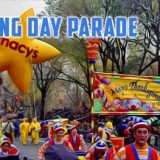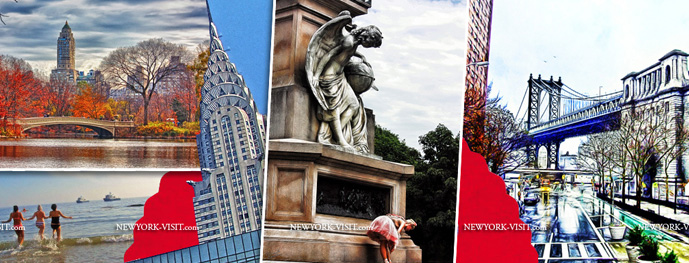Train Station New York City
Train Station – Getting in and around
Train Station
Home » Getting in and around » Coming to NY City » Train Station » info
New York Train Stations
Amtrak (National Train Services)
Trains arrive at New York City’s Penn Station.
Amtrak is the brand name of the intercity passenger train system created on May 1, 1971 in the United States. Officially known as the National Railroad Passenger Corporation, the name “Amtrak” is a portmanteau of the words “American” and “track.”
Amtrak is a quasi-governmental agency; all of its preferred stock is owned by the federal government. The members of Amtrak’s board of directors are appointed by the President of the United States, and are subject to confirmation by the United States Senate. Some common stock is held by the private railroads that transferred their passenger service to Amtrak in 1971. Though Amtrak stock does not pay dividends and is not routinely traded, a small number of private investors have purchased Amtrak stock from its original owners.
Amtrak employs over 19,000 people. The nationwide network of 22,000 miles (35,000 km) of routes serves 500 communities in 46 states of the United States, with some of the routes serving communities in Canada. In fiscal year 2004, Amtrak served over 25 million passengers, a company record.
Long Island Rail Road (LIRR)
Daily commuter service from Long Island and Brooklyn into New York City’s Penn Station.
The Long Island Rail Road or LIRR is a commuter rail system serving the length of Long Island, New York. It is the busiest commuter railroad in the United States, and the oldest railroad still operating under its original name. It is owned by the Metropolitan Transportation Authority, which has styled it MTA Long Island Rail Road.
The LIRR has two major terminals and one minor terminal in New York City. The major terminals are Pennsylvania Station in Manhattan and the Atlantic Terminal at the intersection of Flatbush Avenue and Atlantic Avenue in Brooklyn; the minor terminal is at Long Island City in Queens. The Hunterspoint Avenue station, just east of Long Island City, is served by roughly eight westbound trains and 12 eastbound trains per weekday. Five of those trains in each direction carry passengers to/from Long Island City; all of them continue to the yard at Long Island City. A fourth major terminal is currently under construction. In 2011-2012 the LIRR intends to initiate service to Grand Central Terminal via the East Side Access project; provision was made for this route during the construction of the 63rd Street Tunnel, which runs beneath the East River between the Upper East Side and Long Island City and currently carries the F service of the New York City Subway. Work to be done includes tunneling beneath Manhattan from 63rd Street and the East River across to Park Avenue and then south to Grand Central Terminal, as well as tunneling from the LIRR Main Line near Amtrak’s Sunnyside Yard in Queens to the East River.
There is a major station and transfer point in Jamaica, Queens, where the railroad’s headquarters are located. (The parent MTA is headquartered in Manhattan.) Jamaica Station encompasses eight tracks and six platforms, plus yard and bypass tracks. At Jamaica, passengers can transfer between all western branches, and all eastern branches save Port Washington. Frequent riders of the LIRR use the phrase “change at Jamaica” often. Transfer is also made to the separate facilities for two different subway lines, many bus lines, and the AirTrain automated electric rail system to John F. Kennedy International Airport. There are 11 branches on the LIRR. The longest two are the Main Line and the Montauk Branch, from which diverge six of the remaining nine branches. The Main Line and Montauk Branch each extend to points a few miles short of the end of Long Island’s “forks,” long peninsulas separated by Shelter Island Sound. The line to the North Fork, with limited service east of the prime commuter zone, ends at Greenport, and the line to the South Fork, with both commuter service and extensive seasonal excursion traffic, ends at Montauk.
There are five branches terminating in Nassau County, New York, at Port Washington, Oyster Bay, Hempstead, West Hempstead, and Long Beach; one branch runs through Nassau County but terminates in New York City at Far Rockaway. In addition to the two major branches, there is one subsidiary branch in Suffolk County, New York, to Port Jefferson.
Metro-North Railroad
Daily commuter service from north of New York City, including upstate New York and Connecticut into Grand Central Terminal
The Metro-North Railroad (officially the Metro-North Commuter Railroad Company, and usually abbreviated as Metro-North) is a suburban commuter railroad service between New York City to its northern suburbs in New York and Connecticut. Trains terminate in New York State in Wassaic, Poughkeepsie, Port Jervis, and Spring Valley, and in Connecticut in New Canaan, Danbury, Waterbury, and New Haven. Metro-North also provides local service within the Bronx, and from the Bronx into midtown Manhattan.
Metro-North is operated by the Metropolitan Transportation Authority, which also operates the MTA New York City Transit buses, the New York City Subway and the Long Island Rail Road. The MTA has styled Metro-North as MTA Metro-North Railroad. The MTA announced in October 2002 that it plans to merge the MNCRR and the LIRR into a new entity, to be called MTA Rail Road, which requires approval by the New York State legislature that has failed of passage as of April, 2006. There are also plans to build a new Metro-North station to directly serve the new Yankee Stadium, which is scheduled to open in 2009.
Tickets for travel may be bought from a station agent, automated machine, online, or on the train. There is a 5% discount for buying tickets online, while buying tickets on the train between $4.75 and $5.50 more than standard price regardless of location. Travel between stations located in The Bronx (and Marble Hill, politically located in Manhattan) costs $2.25 per trip regardless of time of day. Also see CityTicket. Again, West of Hudson policies are different due to the trains being operated by NJ Transit.
New Jersey Transit
Daily commuter service from throughout New Jersey, including connections to Philadelphia arriving in New York City’s Penn Station. Service also connects to Newark Airport.
The New Jersey Transit Corporation (usually shortened to New Jersey Transit, NJ Transit or NJT) is a statewide public transportation system serving the US state of New Jersey; New York, Orange, and Rockland counties in New York State; and Philadelphia County in Pennsylvania. It operates bus, light rail, and commuter rail services throughout the state, notably connecting to major commercial and employment centers both within the state and in the adjacent cities of New York and Philadelphia.
Covering a service area of 5,325 square miles (13,790 km2), NJT is the USA’s largest statewide public transit system and the USA’s third largest provider of bus, rail and light rail transit by ridership, linking major points in New Jersey, New York and Philadelphia.
NJT also acts as a purchasing agency for many private operators in New Jersey, with numerous private operators receiving equipment from NJT (primarily buses) for route service within the state not controlled by NJT.
New York City Subway System
The New York City Subway system, a large rapid transit system operated by the Metropolitan Transportation Authority (MTA) in New York City, is one of the most extensive public transportation systems in the world. Depending on the way multi-station complexes and closed stations are counted, there are around 470 stations; the MTA officially reports 468. There are 656 miles (1056 km) of revenue track, with additional non-revenue trackage in shops and yards allowing for a total of 842 miles (1355 km) of trackage.
There is pending legislation that would merge the subway operations of MTA New York City Transit with Staten Island Railway to form a single entity called MTA Subways. The Staten Island Railway operates with R44 subway cars on a fully grade-separated right-of-way, but is typically not considered part of the subway, and is connected only via the free, city-operated Staten Island Ferry.
Though it is known as “the subway,” implying underground operations, about 40% of the system runs on above-ground rights-of-way, including steel and occasionally cast iron elevated structures, concrete viaducts, earthen embankments, open cuts and, occasionally, surface routes. All of these modes are completely grade-separated from road and pedestrian crossings, and most crossings of two subway tracks are grade-separated with flying junctions.






